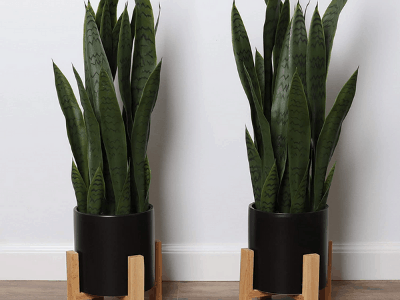Sansevieria Trifasciata, Why So Phenomenal?
Sansevieria trifasciata is the scientific name for snake plant, a member of the Asparagaceae family.
The plants are indigenous to Africa, and Brazil. There are approximately 70 species of these plants.
There are two kinds of this plant with flowering, and both spread by creeping rhizomes.
Leaf length and width are approximately 2.5 inches for the dark green leaves.
Dark green leaves with yellow edges cover some plants with varigated leaves.
These plants are mainly used for ornamental purposes in America.
In Africa, they are used in the production of fiber. Outdoors in warmer climates, these plants can be grown…
…but in colder climates they are used as a decorative houseplant.
You can use them for air purification, removing formaldehyde and benzene from the air.
The fact that they reach upwards makes them extremely desirable in Feng Shui.
When displaying Sansevieria near young children, you should be careful because it’s mildly toxic.
An ingestion can cause swelling of the throat and tongue, as well as problems with the digestive tract.
Here we have Jameson story about this caring and having snake plant for the first time.
Let us hear Jameson’s story
The snake plant is one of the most common plants that people buy for their homes.
It’s a fairly easy plant to take care of and it’ll grow just about anywhere with some light, warmth, and water.
They are either in or near windowsills because they need sunlight.
I can’t remember the last time I watered my snake plant;
it was probably about eight months ago when we had a rainy day here in Los Angeles.
It has been so long since I’ve seen any real rain anymore!
Luckily having this snake plant is this plant no need to having regular watering for it self!
Man, I was so lucky having this plant around. So good to have this plant can act as a decorative plant too!

Snake plant growing actually, not very fast. If you’re talking about the most common snake plant, the Sanseveria trfasciata, as I said, not very fast.
Marlie Graves, professional interior horticulturist.
Here’s the main things that you should know!
Popular plant
Snake plants have adapted to grow in dry climates, but many succulents are too short to stand upright.
Tropical plants are known for their beautiful large leaves and colorful variations.
Leaves with a thick, buttery yellow edge are commonly found, while others have striking dark green stripes.
We also love this plant, since it complements pretty much any style of decor and looks great in arrangements!
It’s no secret that succulents are hardy, and snake plants are no exception.
They’re one of the easiest succulents to take care of, so we recommend them…
…to beginners and people with small thumbs. If you don’t water your snake plant for a month…
…it won’t die, so don’t let your inexperience with gardening keep you from owning this marvelous plant!
Despite the fact that snake plants are tough, you still might need our help to keep your plant looking its best.
The following article will give you information on what makes snake plants…
…so popular along with helpful care tips, with a few fun snake plant facts thrown in for good measure, so keep reading!

Here’s the thing….
Having Snake Plant And Caring It
Few plants possess the dramatic beauty of the Sansevieria, also known as the snake plant.
This plant is known for its elegant leaves, making it a favorite of home décorators and homeowners alike.
There is a Sansevieria in almost every office that contains plants.
Years ago, a small snake plant was given to me as a gift.
This plant’s sword-like leaves instantly caught my eye and also gave it a deep, dark green color.
This plant is still in its original pot, and it is about as tall as I am!
I have several young plants that I have started from the original plant.
Plants such as the snake plant or mother-in-law’s tongue are among the easiest to grow.
There is nothing more beautiful, dramatic, or easier to grow, and it is very hard to kill.
Additionally, they are easy to locate and inexpensive to purchase.
Snake plants are found everywhere if you’re paying attention.
With this beautiful plant, you simply can’t go wrong.

New facts for you!
How Fast Do Snake Plants Grow?
Many easy-care and hardy plants come to mind when on the lookout for plants for your brown thumb.
Among these plants is Sansevieria, the snake plant. The snake plant is a good candidate for a “plant grim reaper”…
…however, you may be wondering how fast the snake plant gets a good root system.
The Growth Rate of Snake Plants
Snake plants grow slowly when exposed to moderate light, either indoors or outdoors.
In the meantime it tends to grow enough, as long as the sun is shining.
The size and shape of your Sansevieria will be determined by the variety…
…that you have planted as well as the growing conditions.
S. trifaciata laurentii is the most commonly planted variety of Sansevieria…
…and is sometimes called Mother-in-Law’s tongue.
They are called this because of their long and sharp leaves that extend from the roots and soil.
Based on the variety of Sansevieria that you have planted, you will eventually see a height and width of 4-6 feet.
S. trifaciata laurentii is the commonest and is also called Mother-in-Law’s tongue.
A long, straight, sharp leaf that reaches from the roots is the reason behind this phenomenon.

Go on…
How Large Do They Grow?
When it comes to snake plants, the S. trifaciata laurentii is the most easily recognized.
The leaves on this plant have irregular snakeskin stripes of snakeskin yellow and green on both sides.
Despite not having many flowers, the little white blooms are sweet-smelling and give the tree its name.
Depending on the sunshine, sunlight intensity and other factors…
…this Sansevieria can grow up to 1-2 feet in height, and sometimes exceeding three feet.
Snake plant also comes in different varieties, one of which is the S. trifaciata.
This variety is similar to the S. trifaciata laurentii but without the laurentii part.
Visually the main difference between them is that its leaves do not have yellow stripes on the sides.
This variety usually grows to the same height as S. trifaciata laurentii.
One variety that is a little more exciting and exotic is the S. cylindrica, or commonly known as the Spear Sansevieria.
The leaves of the S. cylindrica are cylinder like in appearance and very rigid.
These guys leaves are unlikely to bend without breaking once they have matured.
Their leaves usually grow up and out in a fan like manner.
When the leaves are new and supple they are easy to bend and manipulate.
Nurseries and garden centers can take advantage of this and weave the leaves together to create plaits.
This gives the plant a similar style seen with the “money tree” plant.
Different growth rates of snake plants are observed when comparing…
the S. trifaciata and its laurentii compared to the S. cylindrica.
The S. trifaciata/S. trifaciata laurentii can occasionally grow as tall as 3 foot…
…where as the S. cylindrica can grow to a height of over 7 feet.
At the opposite end of the scale is the variety S. trifaciata “hanhii”.
Typically, this variety reaches maximum height of only 4 to 8 inches.
Their coloring is almost identical to that of S. trifaciata laurentii, with yellow stripes surrounding a green interior.
This S. trifaciata variety is a dwarf variety. Because of this it makes an ideal plant for terrariums.

Last but not least…
Stunting the Growth
There are many reasons why you may want to slow the growth of your snake plant.
There are several methods that can be used to stunt the growth of the above varieties.
The simplest way to keep leaves down is to trim them off at the top.
The tip of the Sansevieria leaf produces a hormone that encourages growth.
When you clip the tip off that prevents the hormone from being released and in turn prevents further growth upwards.
For Sansevieria, you can also prevent it from growing outward.
These measurements are determined by the size of the pot the plant is being grown in.
This causes the plant to become root bound if the pot is too small for it.
When roots become root bound, they are forced to contain themselves…
…in an increasingly small area, resulting in more and more dense roots.
Hence, the additional leaves in the plant are prevented from growing away from its base.
Sum Up
See having Snake plant is good choice for you to have! It’s cool, its famous, it’s easy to have and care!
What else do you need? In this pandemic time like this, is a good choice for you to have an new activity…
…and having snake plant is a good choice for you to have!
Conclusion
Last thing for sure. This plant need to be care carefully, remember plant need the “love” too.
Alright that’s all for today! Do you have any questions about all of this?
Or do you want to add some method for having and care snake plant?
Let me know your recommendation from the comment below.
I hope you can now take care your snake carefully and grow it big!
Thanks for reading this article! Bye!

